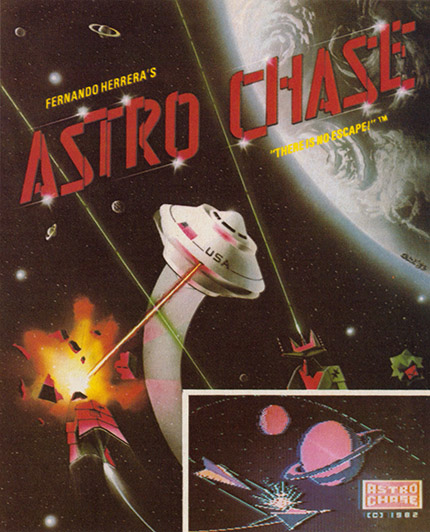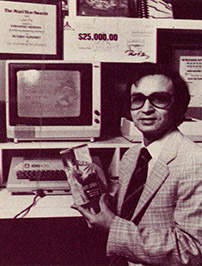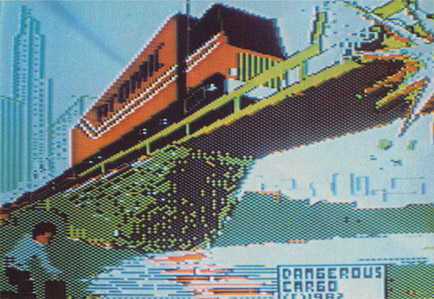
Inside Gaming
Fernando Herrera—First Star in the Atari Universe
Fernando Herrera’s story is so close to a Hollywood film script that it seems fitting that he should join up with two movie producers to develop a computer software company.
The producers, Richard Spitalny and Bill Blake, are best known for their flick “The Night the Lights Went Out in Georgia”, but by joining up with the incredibly gifted Fernando, they may soon eclipse all their past successes.
Fernando first came to EG’s attention via the arrival of a review copy of Space Chase, a science fiction arcade contest written in Atari BASIC. Published by the Long Island-based Swifty Software, Space Chase remains one of the most challenging and innovative SF contests ever produced.
The object of the game is to “conquer” the plethora of planets that dot the extraterrestrial playfield by passing over them. The gamer’s craft, in turn, is pursued by a tie-fighter-styled series of scout ships their sole purpose is to ram and destroy the player’s ship. The player has several weapons at his command. Bombs can be jettisoned from the rear of the rocket as it moves along, destroying any hapless kamikazes on the ship’s tail, and the arcader’s ship can “wraparound” or scroll off the screen at one point and reappear on the other side of the playfield.
If a scout ship’s wiped out, a new craft is instantly generated from the same base. Each scenario the gamer successfully completes brings another enemy base into action until all three of the alien base-stars are pumping out death ships like hamburgers at MacDonalds.
The game is notable for the simple, but perfectly suited graphics, excellent play-action—probably the fastest BASIC program ever written for the Atari computers—and totally original play concept.
When a program of this astonishing quality issues from an obscure programmer via a one-man software house (Swifty is run by an affable schoolteacher named Lee Jackson, a prominent mover in the creation of New York-based Atari computer user groups), the videogame journalist’s instincts immediately take over. What’s the story with this Herrera, we wondered? Where had he been hiding all these years?
The answer, as previously mentioned, is almost too good a story to be true. Born in Bogota, Columbia 39 years ago, Herrera’s artistic talents were evidenced from an early age. He could draw, paint and, by the ripe old age of eight, was making his very own 8mm movies!
After copping a degree in architecture from the National University of Columbia (and finishing in the top 5% of his class) Fernando spent three years pursuing that ambition before moving to the U.S. in 1970. While employed as an Industrial Engineer for a steel company, he also found time to win several chess trophies from the U.S.C.F. (the United States Chess Federation).
In the late 1970’s, however, Fernando discovered an interest that soon replaced his passion for chess—personal computers. He read everything available on the subject, even writing programs himself for a whole year before he actually got around to buying one. It was this new hobby that proved to be not only a door-opener to a new career, but a personal triumph as well.

Fernando’s son, Steve, born with severe cataracts, was pronounced blind by every medical specialist who examined the boy. Fernando, however, refused to accept this judgement and set about to insure that Steve’s education would progress normally. He immediately took steps to create a program to help his boy learn the alphabet. After months of work, Fernando proved the medical profession wrong by successfully utilizing his teaching program, allowing Steve to make great strides in overcoming his handicap.
That program ultimately metamorphosized into My First Alphabet, a design that won Fernando the prestigious first annual Star Award of Merit from Atari in 1981. He became the first designer to win the $25,000 Grand Prize and Atari has now added the highly effective learning aid to its software line. My First Alphabet has proven invaluable in teaching depth perception, size ratios and, of course, the letters of the alphabet themselves.
Today, Fernando is sitting atop the booming market for Atari computer game software. Lead by a canny perception of the audience with which they are dealing, First Star Software, as the embryonic venture is known, will initially deal with a maximum of 32K memory—so that the software will run on any Atari computer.
“A videogame is like a puzzle,” Fernando explains. “You can’t rush it. When it finally comes together, I sit down for 24 solid hours—no food, bathroom, nothing—until it’s completed.”
One of the Atari computer systems’ greatest boosters, Fernando feels certain that, “We have only begun to scratch the surface of what this computer can do. You can do things with the Atari that no other computer can emulate.”
His approach to game design sounds deceptively simple—but it may only work for someone with Fernando’s natural genius with computers. “The user is paramount. I must look at all my programs through the user’s eyes.” He never thinks in terms of the system’s supposed limitations, but rather how to overcome such problems. He speaks in short, concise sentences, tossing off such insightful remarks as, “I don’t move data—I move graphics.”

The first game to be released under the First Star banner will be an arcade quality space shoot-out dubbed Astro Chase. The game revolves around the defense of planet Earth from invading aliens and features not only spectacular graphics, scrolling and audio (or should that be “sound track”?), but a technical innovation that could cause a minor revolution in videogaming. This proprietary process allows the human pilot to lock his craft on course and then fire independently in any direction. Unlike past contests of this type, in which gamers could only fire in the direction of travel, “single thrust propulsion” allows players a flexibility never before available. Imagine running from an alien craft and being able to fire backwards while in the midst of a retreat.
Astro Chase is a sure-fire software hit. Future games will make more use of Spitalny and Blake’s movie background in picking the program concepts. The second scheduled release, Dangerous Cargo, is a trucking game that will also debut in film format sometime next year. The increasing kinship between movies and videogames has only begun to be explored, and the thought of a Fernando Herrera creating a computer game based on, say, “Road Warrior”, is enough to stir the blood of any true arcader.
Fernando, meanwhile, remains unaffected by his sudden celebrity. His main concern is still how to get the best possible game on the TV screen. It’s a job he handles with a star’s touch.
Source Pages




